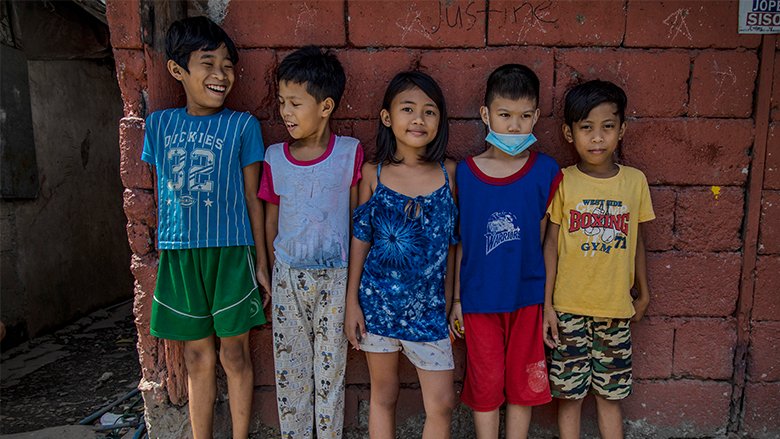Download the full report here.
Key Findings
- Undernutrition is, and has always been, a serious problem in the Philippines.
- For nearly thirty years, there have been almost no improvements in the prevalence of undernutrition in the Philippines. One in three children (29%) younger than five years old suffered from stunting (2019), being small in size for their age.
- The country is ranked fifth among countries in the East Asia and Pacific region with the highest prevalence of stunting and is among the 10 countries in the world with the highest number of stunted children.
- There are regions with levels of stunting that exceed 40% of the population. In Bangsamoro Autonomous Region in Muslim Mindanao 45% of children below five are stunted, in Southwestern Tagalog Region (MIMAROPA) 41%, Bicol Region it is 40%, Western Visayas 40%, and in the south-central Mindanao Region (SOCCKSARGEN) 40%
- Micronutrient undernutrition is also highly prevalent in the Philippines: 38% among infants six to 11 months old; 26% among children 12–23 months; and 20% of pregnant women are anemic. Nearly 17% of children aged 6–59 months suffered from vitamin A deficiency (2018), of which children aged 12–24 months had the highest prevalence (22%) followed by children aged six to 12 months (18%).
- Good nutrition is a foundation for economic prosperity, and investments in nutrition are highly cost-effective.
- The persistence of very high levels of childhood undernutrition, despite decades of economic growth and poverty reduction, could lead to a staggering loss of the country’s human and economic potential. A Filipino child with optimal nutrition will have greater cognitive development, stay in school longer, learn more in school, and have a brighter future as an adult, while undernutrition robs other children of their chance to succeed.
- The burden on the Philippine economy brought by childhood undernutrition was estimated at US$4.4 billion, or 1.5% of the country’s GDP, in 2015.
- The country’s Human Capital Index (HCI) of 0.52 indicates that the future productivity of a child born today will be half of what could have been achieved with complete education and full health.
- In 2013, it was estimated the benefit cost ratio for nutrition investments in the Philippines at 44 (Figure 3.2). In other words, every dollar invested in nutrition has the potential of yielding a $44 return. A lower estimate projecting the benefits accruing from a nutrition intervention scenario (NIS) at the national level through key nutrition-specific interventions rolled out over ten years at full coverage reaches US $12.8 billion over a 10-year period with a corresponding cost of $1,062 million, yielding a benefit cost ratio of 12:1.
- The Impact of COVID-19 on hunger and undernutrition has made it even more urgent for the Government of the Philippines to scale up its efforts to tackle undernutrition.
- Hunger in the Philippines rose sharply following the start of the pandemic. Social Weather Stations (SWS) surveys show that in September 2020, after seven months of community quarantine, 31% of families reported experiencing hunger in the past 30 days, and 9% were suffering severe hunger—in both cases, the highest levels recorded in more than 20 years.
- The key determinants of undernutrition are multisectoral. At the immediate level, a child becomes undernourished because of inadequate or inappropriate food, health, and care.
- At the basic level, poverty is one of the most important causes of undernutrition: 42.4% of children from households in the poorest income quintile are stunted. Governance structures also pose significant challenges for the country’s efforts to combat undernutrition.
Policy and programmatic actions to address the challenge of reducing childhood undernutrition:
- Build a strong and more coordinated partnership for nutrition
- Strengthen the National Nutrition Council to provide the supervisory and oversight capacities needed for programs to run effectively and efficiently and be enabled to respond to gaps in program implementation
- High priority and strong support to nutrition should be the agenda of both the executive and legislative bodies in the municipalities
- Secure adequate financing for nutrition
- “More Money for Nutrition and More Nutrition for the Money”: Secure domestic funding for nutrition-related programs
- Implement at scale, well-proven, direct nutrition interventions
- Adopting an evidence-based package of nutrition-specific interventions that can be made available to each household in all priority LGUs
- Formulating a comprehensive, social behavior change communications strategy targeted at policy makers, health workers and households
- Address determinants of nutrition through multisectoral approaches
- Maternal and child health programs provide the best opportunities for both nutrition-specific and nutrition-sensitive components.
- Implement nutrition sensitive programs aimed at improving dietary quality, access to clean water and sanitation, ensuring that PF serves the most vulnerable populations
- Establish geographic convergence of key sectors
- Establish geographic convergence by key sectors down to the household level and that focus on delivering a basic nutrition package of nutrition-specific and nutrition-sensitive programs to pregnant and lactating women and children younger than 2 years old.
- Data collection and monitoring and evaluation
- Ensure availability of subnational, ethnicity-disaggregated nutrition and nutrition-related data for targeted policy advice and interventions

